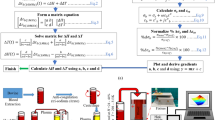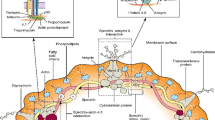Abstract
In order to be able to employ the electrical-impedance method for the measurement of cardiac output in patients on haemodialysis where a wide range of haematocrits may be encountered, a knowledge of the relationship between the resistivity and haematocrit of blood is required. A linear least-squares relationship has been determined for human blood at 37°C and 100 kHz over the haematocrit range from 14 to 45%
Sommaire
Pour pouvoir appliquer la méthode de l'impédance électrique pour la mesure du débit sanguin chez des patients à l'hémodialyse où l'on peut rencontrer use vaste gamme d'hématocrites, il est nécessaire d'avoir des connaissances sur la relation entre la résistivité et l'hématocrite du sang. Une relation linéaire optimale a été déterminée pour le sang humain à 37°C et 100 kHz sur la gamme d'hématocrites de 14 à 45%.
Zusammenfassung
Um die elektrische Impedanzmethode zur Messung der Herzleistung bei Patienten anwenden zu können, die durch Blutidialyse behandelt werden, wo ein breiterer Bereich von Blutzentrifugenwerten angetroffen werden kann, ist die Kenntnis des Verhältnisses zwischen dem spezifischen Widerstand des Blutes und dem Blutzentrifugenwert enforderlich. Es wurde ein Verhältnis nach der linearen Methode der kleisten Quadrate für das menschliche Blut bei 37°C und 100 kHz über einen Blutzentrifugenwertbereich von 14 bis 45% bestimmt.
Similar content being viewed by others
References
Baker, L. E., Judy, W. V., Geddes, L. E., Langley, F. M. andHill, D. W. (1971) The measurement of cardiac output by means of electrical impedence.Cardiovasc. Res. Centre Bull. 9, 135–145.
Frewer, R. A. (1972) The effect of frequency changes on the electrical conductance of moving and stationary blood.Med. & Biol. Engng. 10, 734–741.
Geddes, L. A. (1973) Measurement of electrolytic resistivity and electrode-electrolyte impedance with a variable-length conductivity cell.Chem. Instrum. 4, 151–168.
Geddes, L. A. andSadler, C. (1973) The specific resistance of blood at body temperature.Med. Biol. Engng. 11, 336–339.
Kubicek, W. G., Karnegis, J. N., Patterson, R. P., Witsoe, D. A. andMattson, R. H. (1966) Development and evaluation of an impedance cardiac output system.Aerospace Med. 37, 1208.
Hill, D. W. andThompson, F. D. (1975) The importance of blood resistivity in the measurement of cardiac output by the thoracic impedance method.Med. Biol. Engng. 12.
Rosenthal, R. L. andTobias, W. (1948) Measurement of the electric resistance of human blood; use in coagulation studies and cell volume determinations.J. Lab. Clin. Med. 13, 1110–1122.
Schwan, H. P. (1963) Determination of biological impedances. In:Physical techniques in biological research. Ed. W. Nastuck. New York, Academic Pres, Vol. VIB
Stewart, G. N. (1929) The conductivity of erythrocytes compared with that of serum.Am. J. Physiol. 90, 194–209.
Warburg, E. (1899) Ueber das verhalten sogenanter unpolarisbarer elektroden gegen wechselstrom.Ann. Phys. Chem. 67, 493–499.
Wintrobe, M. M. andLandsberg, J. W. (1935) A standardised technique for the blood sedimentation test.Am. J. Med. Sci. 189, 102.
Author information
Authors and Affiliations
Rights and permissions
About this article
Cite this article
Hill, D.W., Thompson, F.D. The effect of haematocrit on the resistivity of human blood at 37°C and 100 kHz. Med. & biol. Engng. 13, 182–186 (1975). https://doi.org/10.1007/BF02477725
Received:
Issue Date:
DOI: https://doi.org/10.1007/BF02477725




